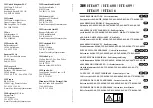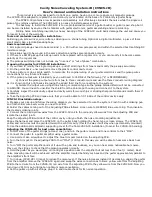
80
FLYNET 100
5.5.6
Printed data string
Through the printed data string it is possible to send to a PC a string containing different data such
as weight, indicator IP address, operation type and so on. The composition of the printed data string
varies depending on the programme installed on the indicator. To know the structure of every single
string, refer to the specific manuals for the installed application.
This type of string can be sent via:
•
Network
•
Serial
5.5.6.1 Transmission of printed data string via network
The parameters available for network transmission are as follows:
Port
6001 is the standard port used to transmit the printed data string externally, it is
possible to open another port if necessary
Protocol
On request
The weighing data are first transmitted and then printed out. With ACK
NAK protocol, if the transmission fails (the ACK command is not sent)
the line "ERROR PRINTED DATA TRANSMISSION ERROR" is added
at the bottom of the printout
With this mode the strings on which this situation occurs are
permanently lost.
Spool
The weighing data are first printed out and then, if the printout ends
correctly, they are transmitted with ACK NAK protocol. If the
transmission fails, the string that was to be transmitted is stored in a
special archive called TxWeighing; in this archive the transmissions
waiting to be transmitted are saved. The transmission of the strings in
the queue is attempted every time the transmission of the weighing
operation in progress must be carried out: if there are already strings in
the queue, their transmission is carried out first, then when the queue
has been emptied the string relevant to the current operation is
transmitted (the transmission takes place in chronological order, from
the oldest string to the most recent one). Each string is deleted from the
queue only after it has been correctly transmitted.
With this mode the weighing operation in progress is slowed down
proportionally to the number of strings present in the TxWeighing
archive, in fact the weighing in progress is completed only at the end of
its transmission.
Archive
The weighing data are first printed out and then, if the printout ends
correctly, they are stored in a special archive called TxWeighing. In
order to retrieve all stored weighing operations from the indicator, the PC
must send the character ENQ (05 hexadecimal or CTRL + E).
If the indicator accepts the transmission request received from the PC by
sending the character ENQ, it extracts from the TxWeighing archive the
data relating to the first weighing contained in the archive (the
transmission takes place in chronological order, from the oldest string to
the most recent one). Each string is deleted from the archive only after it
has been correctly transmitted. After the correct transmission of the last
string contained in the archive, the indicator sends the character EOT
(04 hexadecimal) to the PC to inform it that the archive is now empty.
With this mode the PC must send its enquiry when the indicator is not
performing weighing operations. On the contrary; the weighing operation
in progress may slow down.
Decimal
Comma
Содержание FLYNET 100
Страница 2: ......
Страница 17: ...15 FLYNET 100 Figure 1 13 1 Stainless steel indicator spare parts 1 2 8 4 3 5 10 11 12 13 15 6 7 14 9 ...
Страница 112: ...110 FLYNET 100 ...
Страница 121: ...119 FLYNET 100 10 12 Assembling disassembling the HDMI port ...
















































